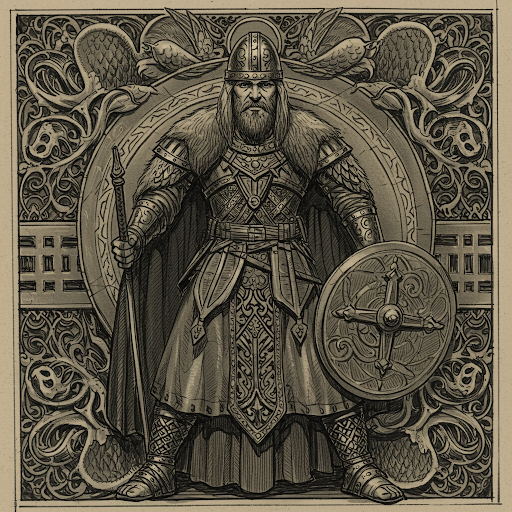What is the Mammen Viking style?
The Mammen Viking style is a celebrated manifestation of Viking decorative art that developed in the second half of the 10th century and the early 11th century in Scandinavia, particularly prominent in Denmark. This art is named after the Mammen axe, a richly decorated ceremonial object discovered in an aristocratic grave near the village of Mammen in Jutland, Denmark. This axe, along with other sumptuous objects, displays silver decorations inlaid with complex animal and plant motifs, representing the most iconic example of this artistic style.
Main Characteristics of the Mammen Style
- Animal and plant motifs: In the Mammen style, semi-naturalistic animals such as birds, lions, and serpents are prominent, accompanied by well-defined plant motifs, such as tendrils, curls, and leaves. These elements often intertwine in dynamic and asymmetric compositions, rich in turns and unexpected twists.
- European influences: Although deeply rooted in Scandinavian tradition, the Mammen style incorporates elements of Western European art, adapting them to Nordic taste. This is reflected in the use of plant volutes and wavy shapes that denote clear continental influences.
- Zoomorphic decoration: Following the legacy of earlier styles such as Jelling, the Mammen style continues to use the serpent motif but adds richness and detail with more robust and realistic animal figures. In some cases, these animals are decorated with geometric or ornamental details, as seen in the famous Mammen axe.
- Materials and techniques: Mammen style creations are found in various materials, such as silver, iron, ivory, wood, and stone. These works demonstrate the high technical level of Viking artisans, especially in inlay and precise engraving techniques.
- Geographical distribution: Examples of this style have been found not only in Denmark but also in countries such as Germany, Poland, and even the Iberian Peninsula, which evidences the wide influence of Viking art in Europe.

Iconic Pieces of the Mammen Style
- Mammen Axe: This ceremonial object is decorated with elaborate intertwined animal motifs and a large stylized bird. It was a symbol of status and power in its time.
- Great Jelling Stone: It stands out for introducing the "great beast" motif, a future symbol of Viking art, and for representing Christ in a stylized manner, adapting to Nordic symbolism.
- Chests from Cammin and Bamberg: These chests, crafted from ivory and other precious materials, are decorated with intertwined animals and plant motifs of the style, reflecting the artistic and decorative breadth of Mammen.
Importance and Influence
The Mammen style symbolizes the transition from early Viking art to more complex and sophisticated decorative forms that would later flourish, such as the Ringerike style. Its peak coincided with the reign of Harald Bluetooth and spread along Viking trade routes and settlements in Europe. Although its prominence was relatively short-lived, the Mammen style left an indelible mark on the history of Scandinavian and European art, reflecting the cultural richness and cosmopolitanism of Viking society at the end of the 10th century.




























